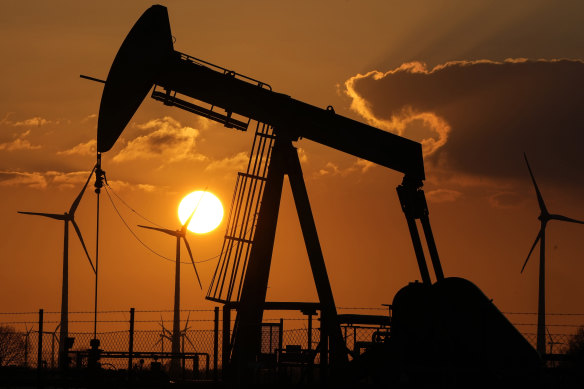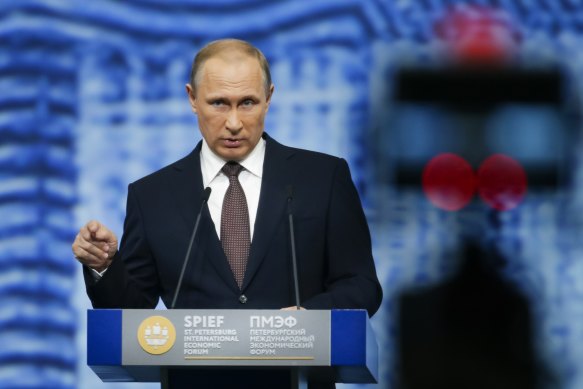The challenge for OPEC+ and the Saudis, as the most important producer within the cartel, is that, even as the price has fallen back amid relatively weak demand, Russia has been pumping out as much oil as it can produce to try to maintain the revenues it needs to fund the war in Ukraine.
Russia had announced its own cut of 500,000 barrels a day from a February baseline, but there are no signs that the reduction has been effected, despite Russia’s claims. Last month, Russia was shipping oil at a rate almost 500,000 barrels a day higher than in February.

Saudi Arabia is cutting oil production by 1 million barrels a day, taking it to its lowest level in several years.Credit: AP
That’s not evidence that the West’s sanctions aren’t working.
They were designed to leave an incentive for Russia to continue to produce and sell its oil and avoid a massive spike in oil prices, while reducing the revenue it generates from those sales via the $US60-a-barrel cap on oil transported by ships financed or insured by the UK, European and US insurers and reinsurers who dominate the market.
While Russia may be selling some of its oil at or above the cap, shipping it via a vast “grey” or shadow fleet of tankers it has assembled, Russia’s oil and gas revenues were 64 per cent lower in April than a year earlier and the squeeze on them was so acute that the Russian government changed the way it taxes its oil and gas producers to increase its share of their revenues – and decrease their earnings and ability to invest in future production.
Having been denied access to their former major markets in Europe by sanctions, Russia has been greatly increasing its sales to China and India and other Asian countries, markets from which the Saudis traditionally extracted premium prices.

Vladimir Putin’s Russia has been greatly increasing its oil sales to China, India and other Asian countries, which are markets the Saudis traditionally extracted premium prices from.Credit: AP
That would be a source of irritation and friction within the relationship between the Saudis and Russians.
The Saudis, according to the International Monetary Fund, need an oil price above $US80 a barrel to balance their budget and fund the extravagant projects that Crown Prince Mohammed bin Salman has embarked on to try to create an economy that can withstand declining demand for oil in a decarbonising global environment.
Russia’s need to maintain volumes to offset the sanctions-driven loss of margin isn’t helping the Saudis, who have already borne the larger share of a series of production cuts in the past 12 months as OPEC+ tried to balance a supply-demand equation that was impacted last year by China’s zero-COVID policy and the war in Ukraine and which continues to be coloured by slower-than-expected global growth.
The challenge for OPEC+ and the Saudis is that, even as the prices has fallen back amid relatively weak demand, Russia has been pumping out as much oil as it can produce to try to maintain the revenues it needs to fund the war in Ukraine.
China hasn’t bounced back as significantly as expected after it abandoned the zero-COVID policy late last year. Recent economic data shows an economy struggling to regain momentum. It will be a challenge to achieve this year’s modest (by China’s standards) target for growth of around five per cent.
Moreover, China’s response to the West’s sanctions on Russia and Russian oil last year was to buy as many heavily-discounted cargoes at it could. It now appears to have satiated its own demand to the extent that it is reported to have been on-selling cheap Russian oil (at a profit) that is surplus to its needs.
The rest of the world is, of course, facing its own challenges, with the sharp rise in interest rates in developed economies to combat stubbornly high levels of inflation designed to choke off growth and likely to end in economic contraction and possibly recessions.
Loading
OPEC+ had expected a big rebound on demand for oil and in the oil price in the second half of this year but, unless China’s economic engine stops sputtering and starts roaring, that would seem unlikely, which leaves further manipulation of the supply side as its major lever.
From the outcome of the weekend’s meeting, it appears only the Saudis have the appetite for further production cutbacks and then only for a month at a time.
The Business Briefing newsletter delivers major stories, exclusive coverage and expert opinion. Sign up to get it every weekday morning.
Stay connected with us on social media platform for instant update click here to join our Twitter, & Facebook
We are now on Telegram. Click here to join our channel (@TechiUpdate) and stay updated with the latest Technology headlines.
For all the latest Business News Click Here
For the latest news and updates, follow us on Google News.
